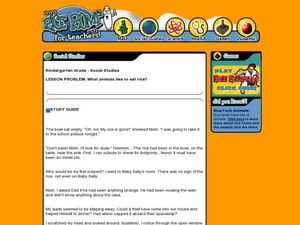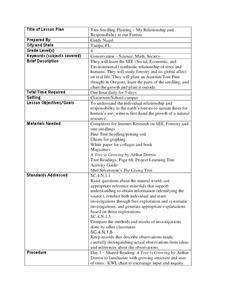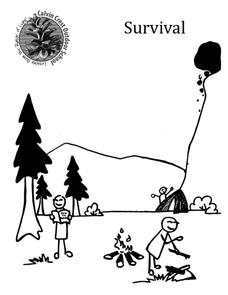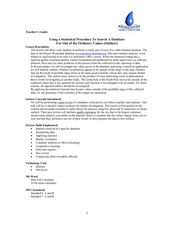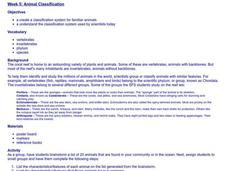Curated OER
Can you think of pictures that will tell a story about rice?
First graders use pictures and letters to create a rebus. In this writing sentences lessons, 1st graders analyze sample rebuses as a class and read a rice rebus independently. Students make three rebus sentences. Students play a...
Curated OER
Family Letter - Order of Operations and Sequences
In this order of operations and sequences worksheet, middle schoolers solve 16 short answer problems. Students create an arithmetic sequence by adding seven to a number. Middle schoolers perform operations on numbers in various order to...
Florida International University
The Good, the Bad and the Nasty Tasting
Examine the benefits of chemical defense mechanisms. Organisms in oceans use chemicals to ward off predators. Duplicate this adaptation using a hands-on experiment in which you ward off your predators (your pupils) with some...
Curated OER
Making the Most of the Internet
Children listen as the teacher tells them about Childnet. Young scholars use the CD-ROM and internet sites to answer questions on the worksheets. Students learn to navigate the sites and search techniques. If time and interest allows, an...
Curated OER
Planet Dance
Students examine Anna Halprin's philosophies and choreography and perform one of her Planet Dances. They find a site that inspires them to create a dance based on the environment's design, levels, textures, and atmosphere.
Curated OER
Reproduction and Development
In this human reproduction worksheet, students will review the male and female anatomy and the hormones involved in the development towards sexual maturity. Students will also review the events that occur during the three phases of the...
Curated OER
What is an Animal?
In this animal classification worksheet, students will review the characteristics used in classifying animals including the development of animals. Students will compare the endoderm, ectoderm, and mesoderm. This worksheet has 4 short...
Curated OER
John Muir Nature Journal
Students explain how John Muir carefully and quietly observed nature and record his observations in his journal with writings and drawings. Students create their own nature observation journal.
Curated OER
Sociology: What is life like for Gulf Coast rice farmers
Students read 1 page about Gulf Coast rice farmers and then describe what rice farming in the U.S. is like in the United States. In this rice farming lesson plan, students tell why they would or would not want to be a rice farmer.
Curated OER
Sponges
In this sponges worksheet, students will explore the characteristics of sponges including their different types of cells and body structures. Students will also determine how sponges reproduce. This worksheet has 3 short answer and 11...
Curated OER
Roots, Stems, and Leaves
For this plant worksheet, students review the structure and function of roots, stems, and leaves. This worksheet has 5 matching, 7 true or false, 4 multiple choice, and 10 fill in the blank questions.
Curated OER
Animals who eat Rice
Students read a story and answer questions. In this reading for understanding lesson, students read a story and answer questions. Students also draw pictures of the story to help comprehension.
Curated OER
Rice Plants
Second graders investigate what plant is closely related to to rice. In this rice farming lesson, 2nd graders dicover the parts of rice and that rice is closely related to grass. Students create a rice picture and write sentences...
Curated OER
What is effective communication?
Middle schoolers practice a series of communicaton activities. In this communication skills lesson, students role play listening and active listening strategies to improve communication. Middle schoolers write a set of guidelines for...
Curated OER
Tree Seedling Planting- My Relationship and Responsibility to our Forests
In this trees lesson, 4th graders read the book, A Tree is Growing and complete a KWL chart on how trees grow and how they are used. Students research the symbiotic relationship of humans and trees, create tree collages, plant a...
Curated OER
Co-evolution of Plants and Pollinators
Students explore biological evolution and natural selection and its evolutionary consequences. They also explore how organisms are interdependent on one another.
Curated OER
Ecological Succession in Pond Water Cultures
Students collect samples of pond water, dried grass, and soil in a jar. They predict the order of ecological succession in their pond water cultures. They compare their expected results with their observed results.
Curated OER
Bug Sweep
Students observe and categorize insects. In this insects science lesson, students create a bug catcher out of a coat hanger and plastic bag, then collect bugs from the schoolyard. Students count and categorize the insects according to...
Curated OER
Molded Clay Faces
Artists create clay masks using pre-formed molds, clay, glitter, feathers, gems, and paint. The expressive qualities of clay are perfect for creating many different types of face masks, from Mardi Gras glitter to Japanese Kabuki to...
Calvin Crest Outdoor School
Survival
Equip young campers with important survival knowledge with a set of engaging lessons. Teammates work together to complete three outdoor activities, which include building a shelter, starting a campfire, and finding directions in the...
Curated OER
Using a Statistical Procedure To Search A Database For Out of the Ordinary Values
Learners develop a spreadsheet containing formulas and find summaries for them. In this investigative lesson students choose a topic, investigate it and use MS Excel to sort data.
Curated OER
Watersheds, Watersheds Everywhere
Students identify the watershed in which their school is located. They use maps to locate their homes and school. They define and use the correct vocabulary.
Curated OER
Sars
Students discuss the Sars outbreak in 2003. In this biology instructional activity, students research the effect of the outbreak to the world. They create a public announcement about the topic.
Curated OER
Animal Classification
Students list characteristics and features of animals found in their community. They then group the animals according to how they are similar and different and create names for each group. They then create a chart of their...













